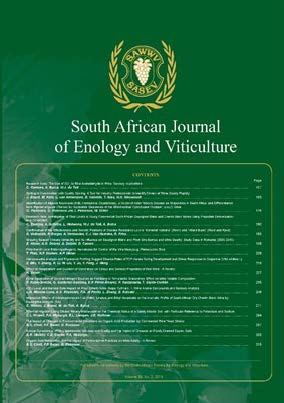Effect of Temperature and Duration of Maceration on Colour and Sensory Properties of Red Wine - A Review
DOI:
https://doi.org/10.21548/39-2-3160Abstract
The maceration process plays an important role in the composition of the colour and sensory properties of red wine by facilitating the extraction of phenolic and aromatic compounds found in grapes. This review summarises the key findings from a study of the literature associated with research on the effects of the temperature and duration of maceration on the phenolic content, colour and sensory properties of red wine. In the past, many researchers have reported that higher maceration temperatures increase the extraction of phenolic compounds and enhance red wine colour, but low-temperature pre-fermentative techniqueshave become more popular in recent years due to their positive effects on wine composition, including lower oxidation of anthocyanin pigments and aroma compounds, inhibition of undesirable enzymatic activities, and an environment that is less conductive to microbial growth. Macerations carried out at low temperature ranges (10°C to 15°C) result in red wines with the highest levels of total phenolic content, anthocyanin and colour intensity, and richer fruity, flowery and spicy aroma. The duration of maceration has also been shown to have significant effects on red wine phenolic compounds, colour properties and the relevant sensory attributes. Studies show that prolonged maceration leads to a stable red colour, as well as richer tannin content, polymeric pigments and astringency. Red wines with appropriate colour and sensory characteristics can be produced by adapting both maceration temperature and duration to the desired style.
Downloads
Downloads
Published
Issue
Section
License
A copyright form will be e-mailed to the corresponding author when the manuscript has been accepted for publication.
In principle, the Author agrees to the following when he/she signes the copyright agreement:
I hereby assign to the SOUTH AFRICAN SOCIETY FOR ENOLOGY AND VITICULTURE (SASEV) the copyright of the text, tables, figures, supplementary material, illustrations and other information (the Material) submitted with the manuscript to be published in SOUTH AFRICAN JOURNAL OF ENOLOGY AND VITICULTURE (SAJEV) (the "Article"). The copyright becomes effective from the date the Article has been accepted for publication in SAJEV.
This is an open access journal, and the authors and journal should be properly acknowledged, when works are cited.
Author's may use the publishers version for teaching purposes, in books, theses, dissertations, conferences and conference papers.
A copy of the authors' publishers version may also be hosted on the following websites:
- Non-commercial personal webpage or blog.
- Institutional webpage.
- Authors Institutional Repository.
The following notice should accompany such a posting on the website: This is an electronic version of an article published in SAJEV, Volume XXX, number XXX, pages XXX - XXX, DOI. Authors should also supply a hyperlink to the original paper or indicate where the original paper (www.journals.ac.za/index.php/sajev/) may be found.
Authors publishers version, affiliated with the Stellenbosch University will be automatically deposited in the University's Institutional Repository SUNScholar.
Articles as a whole, may not be re-published with another journal.
The following license applies:
Attribution CC BY-NC-ND 4.0

